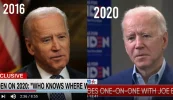Phoenix68
Well-Known Member
- Joined
- Mar 12, 2022
- Messages
- 14,575
.
How George Bush Sr. Almost Got Indicted for Fraud
.
1993 deficit reduction: A Lesson on Tax Policy
.
President Clinton announces another record budget surplus
.
Bush's tax cuts `sounded too good to be true' for Democrats
.
"U.S. Economy Screwed"
.
Bush Era Tax Cuts Didn't Fix Economy
.
Obama Outperforms Reagan On Jobs, Growth And Investing
.
President Obama’s policies revived the economy
.
The Obama recovery is about to make Trump look good
.
Comparing The "Trump Economy" To The "Obama Economy"
.
Biden's Economic Performance Has Proved Unbeatable
.
517,000 Jobs In January; Surprisingly Strong Growth In Labor Market
How George Bush Sr. Almost Got Indicted for Fraud
.
1993 deficit reduction: A Lesson on Tax Policy
.
President Clinton announces another record budget surplus
.
Bush's tax cuts `sounded too good to be true' for Democrats
.
"U.S. Economy Screwed"
.
Bush Era Tax Cuts Didn't Fix Economy
.
Obama Outperforms Reagan On Jobs, Growth And Investing
.
President Obama’s policies revived the economy
.
The Obama recovery is about to make Trump look good
.
Comparing The "Trump Economy" To The "Obama Economy"
.
Biden's Economic Performance Has Proved Unbeatable
.
517,000 Jobs In January; Surprisingly Strong Growth In Labor Market

![sleeping-in-hammock[1].gif sleeping-in-hammock[1].gif](https://www.houseofpolitics.com/data/attachments/3/3348-b0d6a1742e739209012e5791e96b5988.jpg?hash=sNahdC5zkg)
![happy-dance-smiley-emoticon[1].gif happy-dance-smiley-emoticon[1].gif](https://www.houseofpolitics.com/data/attachments/3/3374-c5dcf6e814635ba2058a6de2061b9f63.jpg?hash=xdz26BRjW6)
![120428121758-bunker-4-story-top[1].webp 120428121758-bunker-4-story-top[1].webp](https://www.houseofpolitics.com/data/attachments/5/5246-333279a32129780c56478b166e33c9f4.jpg?hash=3iMQeFh9Gx)
![ab1b3ee76c0e44919c0f74d86beea32d[1].webp ab1b3ee76c0e44919c0f74d86beea32d[1].webp](https://www.houseofpolitics.com/data/attachments/5/5248-5ead3475fe90b579efcd88d4d0bcda21.jpg?hash=O_Et_LiU-H)
![relaxing-outside-smiley-emoticon[2].gif relaxing-outside-smiley-emoticon[2].gif](https://www.houseofpolitics.com/data/attachments/5/5249-581aa3adf5fd8cf2efe03ad431d1514e.jpg?hash=WBqjrfX9jP)
![tumblr_mhp7ghh1es1s2jx30o1_1280[1].webp tumblr_mhp7ghh1es1s2jx30o1_1280[1].webp](https://www.houseofpolitics.com/data/attachments/5/5930-aef946d50fddad438692bc791189a16d.jpg?hash=PDrKq1nvxM)
![smiley%20think[1].webp smiley%20think[1].webp](https://www.houseofpolitics.com/data/attachments/5/5931-fb685868d55d147104a3a44766120c9c.jpg?hash=9PgTg3KfYI)


![abbie_hoffman[1].webp abbie_hoffman[1].webp](https://www.houseofpolitics.com/data/attachments/6/6494-875e639186e288cbabff80ae46bf21ef.jpg?hash=Nmh7ZOPHZO)
![raspberry-smiley-emoticon[1].gif raspberry-smiley-emoticon[1].gif](https://www.houseofpolitics.com/data/attachments/6/6495-7dfc89e9b9588cf26dfb505ee8c5ada7.jpg?hash=ffyJ6blYjP)